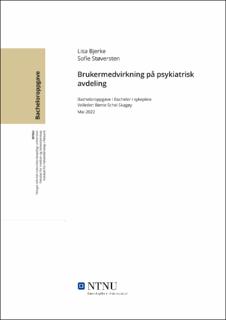| dc.contributor.advisor | Skagøy, Bente Schei | |
| dc.contributor.author | Bjerke, Lisa | |
| dc.contributor.author | Støversten, Sofie | |
| dc.date.accessioned | 2022-07-16T17:22:14Z | |
| dc.date.available | 2022-07-16T17:22:14Z | |
| dc.date.issued | 2022 | |
| dc.identifier | no.ntnu:inspera:112446249:113819543 | |
| dc.identifier.uri | https://hdl.handle.net/11250/3006226 | |
| dc.description.abstract | Hensikt: Hensikten med oppgaven var å undersøke hvordan sykepleiere som jobber på psykiatrisk avdeling (spesialisthelsetjenesten) kan tilrettelegge for brukermedvirkning.
Metode: Oppgaven er en systematisk litteraturstudie, der åtte forskningsartikler ble valgt ut for å besvare problemstillingen vår. Artiklene ble funnet i fire helserelaterte databaser, samt gjennom ett manuelt søk. Utvalgte artikler er hovedsakelig kvalitative studier publisert mellom 2011 og 2021.
Resultat: Vi identifiserte at relasjonsarbeid, gode holdninger, informasjonsflyt og høyt kunnskapsnivå hos sykepleier bidrar til brukermedvirkning. Symptomer, ressursknapphet og kultur på avdelingen hemmet brukermedvirkning. Involvering av pårørende både bidro til og hemmet brukermedvirkning.
Konklusjon: God relasjon danner produktiv samhandling, der pasienten lettere deler tanker og ønsker med sykepleier. Tilstrekkelig, tilpasset og forståelig informasjon, bidrar til at pasienten tar beslutninger som gagner egen helse. Sykepleier bør søke veiledning og samarbeid hos personer med riktig kompetanse, hvis en ikke innehar nok kunnskap for å bidra til brukermedvirkning. I enkelte situasjoner kan det være nødvendig med en balanse mellom paternalisme og brukermedvirkning, spesielt for de svært symptompregede pasientene. Sykepleier må bidra med gode holdninger og brukermedvirknings-kultur, uavhengig av avdelingens økonomiske forutsetninger. | |
| dc.description.abstract | Aim: The aim of this study was to examine how nurses who work in a psychiatric ward can facilitate user participation.
Method: The study is a systematic literature study, where eight research articles were selected to answer our research question. The articles were discovered in four health-related databases, as well as through one manual search. In general, the articles were qualitative studies, published between 2011 and 2021.
Results: We identified that relationship building, good attitudes, information flow and a high level of knowledge among nurses, contributed to user participation. Symptoms, resource scarcity and culture in the ward hampered user participation. Involvement of relatives was both a facilitator and a barrier to user participation.
Conclusion: A good relationship forms a productive interaction, where the patient more easily shares thoughts and wishes with the nurse. Adequate, adapted and understandable information contributes to the patient making decisions that benefit their health. The nurse should seek guidance and cooperation from people with appropriate knowledge, if they lack the necessary competence to facilitate user participation. In some situations, a balance between paternalism and user participation may be necessary, especially for patients with pronounced symptoms. The nurse must contribute with good attitudes and user participation culture, regardless of the financial prerequisite of the ward. | |
| dc.language | nob | |
| dc.publisher | NTNU | |
| dc.title | Brukermedvirkning på psykiatrisk avdeling | |
| dc.type | Bachelor thesis | |
